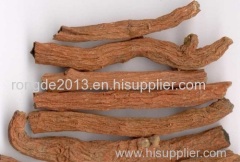|
Xi'an Rongde Import and Export Trade Co., Ltd
|
10%-98% Salicin powder health care
| Price: | 15.0~20.0 USD |
| Payment Terms: | T/T,L/C,D/A,D/P,WU |
| Place of Origin: | Shaanxi, China (Mainland) |
|
|
|
| Add to My Favorites | |
| HiSupplier Escrow |
Product Detail
Latin name: Salax Alba, Salix Purpurea L.
Part of plant used: Bark (cortex)
Active ingredients: Salicin
Standard: 10%-98% Salicin
Common name: White Willow, Pussy Willow, Purple Willow
Latin name: Salax Alba, Salix Purpurea L.
Part of plant used: Bark (cortex)
Active ingredients: Salicin
Standard: 10%-98% Salicin
Description
The bark of the common Willow tree has been known since antiquity for its pain-relieving and fever-reducing properties. In the early 19th century a French chemist extracted the principal active ingredient from Willow Bark and named it Salicin. At the end of the century, Felix Hofmann, a chemist at the Bayer company in Germany developed the world's most used medication, aspirin or acetylsalicylic acid. Recently, however, pain sufferers are returing to the natural source to avoid the potential dangerous side effects of aspirin.
Pharmacology
Willow Bark contains bitter phenolic and flavonoid glycosides. The most famous and active phenolic glycoside is salicin, which is a monoglycoside of salicylic acid. Salicylic acid is a weak anti-inflammatory agent but is converted by the liver to acetyl-salicylic acid. The acetylated version has aspirin's more effective anti-inflammatory activity without its gastrointestinal toxicity. The salicylates inhibit the activity of the cyclooxgenase enzyme and thus inhibit the production of prostaglandins and other inflammatory molecules.
Active properties
Willow bark has long been used for fevers and inflammations. In addition, the astringency of the glycosides makes wilow bark useful as an antiseptic and astringent. Extracts and infusions of the bark have been used for cleansing the scalp and skin, for treating dandruff, and for treating corns and growths.
Indications and Uses
Salicin is closely related in chemical make-up to aspirin and has a very similar action in the human body. When consumed, it is metabolized to salicylic acid.Salicin safely be taken long-term at recommended doses. Higher than commonly recommended doses of this herb can cause stomach upset, nausea, or tinnitus (ringing in the ears). If any of these reactions develop. Stop taking the herb.
Avoid white willow bark, which can irritate the stomach, if you are sensitive to aspirin, or if you have an ulcer or other gastrointestinal disorder.
As with aspirin products, never give white willow bark to children or teenagers under age 16 with symptoms of the cold, the flu, or chicken pox. Although white willow bark is unlikely to cause the rare but potentially fatal condition called Reye's syndrome in such cases—it is metabolized differently than aspirin—the similarity to aspirin is close enough to warrant caution.
Historical uses
Temporary use in pain: headache, menstrual pain, toothache, arthritis, gout, angina, sore muscles.
Antiseptic for urinary tract in fections.
Fevers, rheumatic conditions.
Inflammatory pain.
Connective tissue disorders.
As an astringent for dysentery, diarrhea, intestinal worms and parasites.
Storage: Store in cool & dry area, keep away from the direct light and heat.
Shelf life: Two years in proper storage.
Packing: 25 KG / fiberboard drum or as the customer's request












